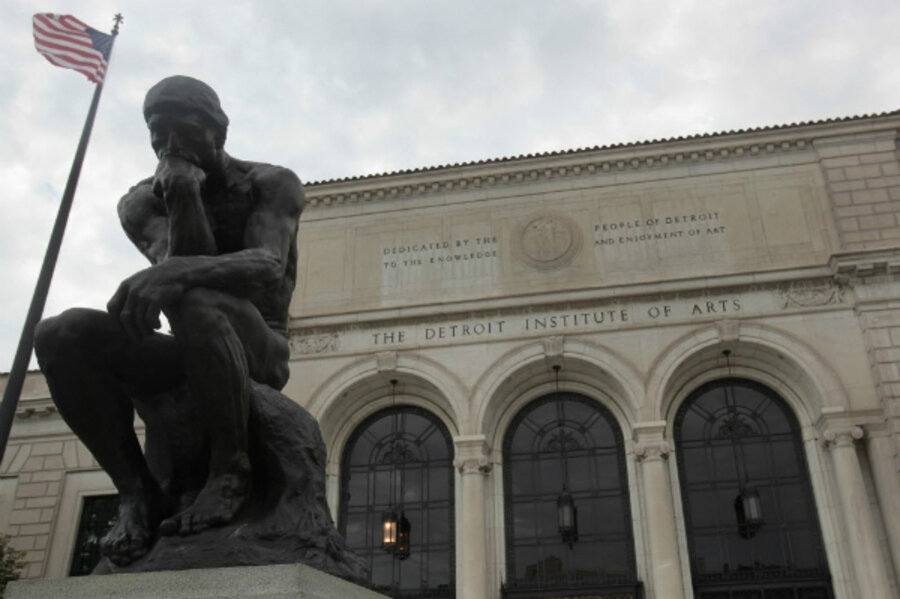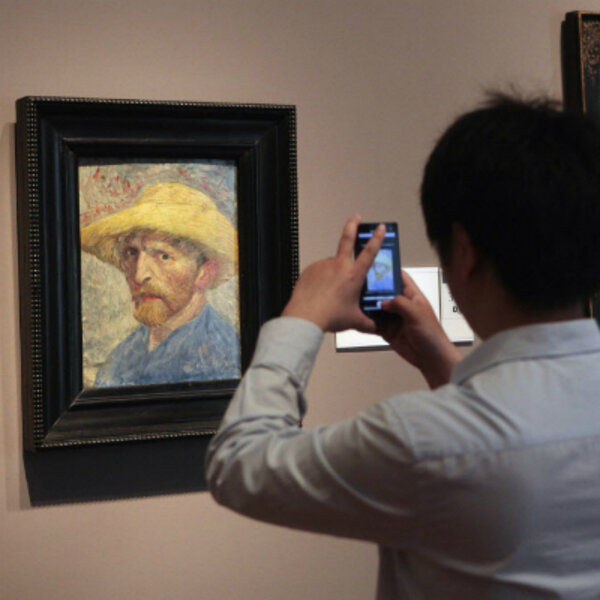Detroit bankruptcy: Will city's storied art collection be sold?
Loading...
| Chicago
Besides looking for ways to cut operating costs and assessing obligations to pensioners and retirees, a bankrupt Detroit is also turning to its public assets, such as its airport, parking garages, and its publicly owned art to find ways to chip away at its $11.5 billion of unsecured debt.
The potential sale of its public art collection, which includes masterworks by Rodin, Degas, Van Gogh, and Cézanne, is generating the most controversy. Emergency financial manager Kevyn Orr announced Monday that he is hiring Christie’s Appraisals Inc., the famed New York City auction house, to appraise a portion of the collection at the Detroit Institute of Arts on the behalf of creditors who are requesting the assessment, which then might be used in a sale or leasing situation to help pay back the debt.
Creditors have good reason to demand the assessment. When Mr. Orr announced Detroit was filing for Chapter 9 bankruptcy in July, he said he wanted to stop paying unsecured debt to creditors and, instead, restructure the terms to offer them 10 cents or less on the dollar.
But Orr is assuring the public that he is looking at the art collection, among other assets, as a way to “create value from the asset without a transfer of ownership.”
“Our goal is to preserve the value of all of the city’s assets and make sure they are rationalized in a way that value can be returned to its citizens and, in certain cases, enjoyed by Detroit metro area’s residents for many years to come,” he said, in a statement released Monday.
Certain pieces of the museum’s 60,000-piece collection are off-limits, if their original benefactor stipulated they can never be sold, but Orr has the right to sell pieces without those barriers. It's unlikely he will do it, says Stephen Selbst, chair of the bankruptcy department at Herrick, Feinstein, a New York City law firm. Under the terms of a Chapter 9 bankruptcy, Mr. Selbst says, the court cannot determine which assets, if any, should be sold, leaving the decision solely in Orr’s hands.
“My guess is that Kevyn Orr is getting the appraisal to demonstrate to creditors there are no sacred cows and he will at least consider the sale of property. But at the end of the day, creditors can’t force him to sell it,” Selbst says.
Orr could potentially lease the artwork as collateral to raise money for a loan, says Dennis Enright, a national expert in privatization of government assets with NW Financial in Hoboken, N.J.
“You could create a revenue stream around it. It’s definitely not a normal governmental world activity, but certainly private collectors use their art as collateral and bet it against for their own private interests,” Mr. Enright said.
The Detroit Institute of Arts is considered in “the top five” of US art museums, says Henry Adams, an art historian at Case Western Reserve University in Cleveland. Some of its prized works are “Saint Jerome in His Study” by Jan Van Eyck, which is “hugely significant” and was once owned by the Medici family in Florence, Italy, and "Nocturne in Black and Gold: the Falling Rocket" (1875), by James McNeill Whistler, which Professor Adams views as the world’s first abstract painting. “In essence, modern art comes out of that painting,” he says. [Editor's note: The original was changed to correct the name of a painting.]
Because such unique works rarely, if ever, come to the market, Adams says that the appraisal will be extremely difficult.
“You don’t have anything close to compare it to. They’ll come up with a figure, but there’s a lot of guesswork there,” he says. The only market the paintings might find buyers is China and the Middle East," Adams says. “In this moment in the art market, that’s where the really big money is.”
The city owns the museum’s building, property, and collection. In a statement released Monday, the museum said it supports Orr’s efforts but that “he undercuts that core goal of getting the city back on a sustained path to solvency by jeopardizing Detroit’s most important cultural institution.”
Since Detroit is the largest city in the US to declare Chapter 9 bankruptcy, any decision Orr makes will be unprecedented – and closely watched. Many cities have sold their assets to pay creditors or to fill budget gaps; however, none faced the task at such a large scale. Orr said Monday he is also hiring outside experts to appraise the value of the city’s parking garages and meters, the Detroit-Windsor Tunnel, the Coleman A. Young International Airport, and certain municipal real estate holdings.
“There’s never been a case like this,” says Selbst.
If the politically risky decision would be to sell Detroit’s art, the politically expedient one would be to sell off its vast acreage of vacant land, left abandoned due to systemic population loss over decades, Selbst says.
“You have tens of thousands of lots that the city owns by virtue of default of property taxes, and no one in Detroit would argue if you sold them,” he says. “In a sense, the art is [also vulnerable to a sale] but the political stakes are immeasurably higher. No one would blink at the sale of abandoned property, but when you talk about Diego Rivera murals, people will be upset.”
The challenge of real estate is that it is susceptible to unstable markets. For example, officials in Pontiac, Mich., were forced to sell the Pontiac Silverdome, an 80,300-seat stadium once valued at $20 million, for just under $600,000 in 2009. And some privatization efforts also carry a political risk, such as when Chicago Mayor Richard M. Daley sold the city’s parking meter system to Morgan Stanley for more than $1 billion in 2008; the issue continues to be a lightning rod under the Rahm Emanuel administration, especially after Morgan Stanley hiked parking rates and independent investigations revealed that the deal was undervalued.
Despite those risks, Orr is likely looking at long-term assets to privatize, such as the water and sewer systems, and garage and meter parking, because they are traditionally “assets that are the most interest to investors in the market,” says Enright of NW Financial.
“The value will be created, in part, by [raising] rates over time, which the city probably hasn’t been doing. By doing that, you can monetize those [assets] into longer-term cash flows and entice the private sector to participate,” he says.









